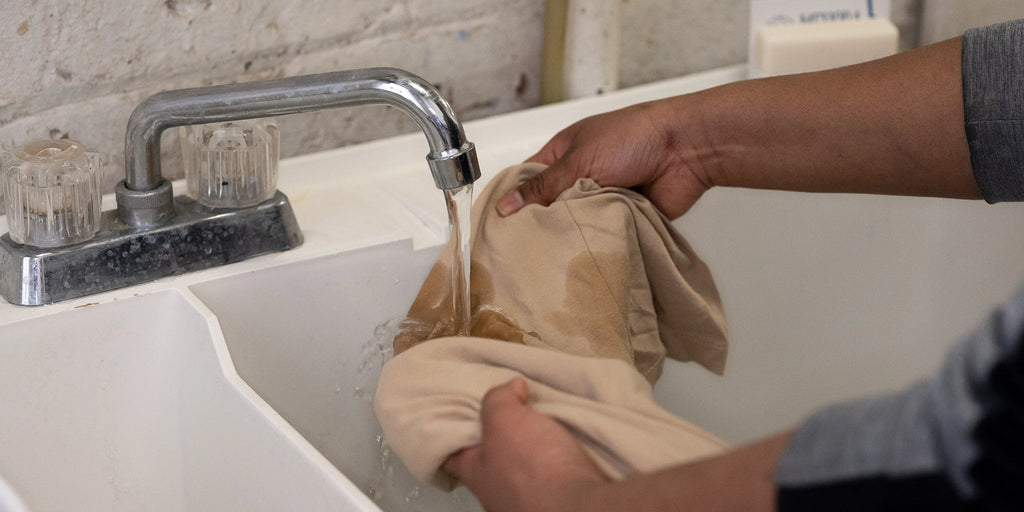You don’t need harsh chemicals or liquid formulas to remove stains. A good stain remover soap can handle almost any stain and is safe for most fabrics. We’ve put together a guide with all the how-tos and FAQs you need to use our Soap Stick effectively!
How to use Soap Stick
Our easy-to-use Soap Stick combines the cleaning power of soap with the scrubbing power of friction to lift away fabric stains. For best results, follow these steps:
- Check the fabric care instructions to make sure stain removers are safe to use
- Treat the stain as soon as possible
- Use the right water temperature for the stain
- Wet the stained area of the fabric with warm water
- Rub the soap stick vigorously on the stained area to create friction and work up a lather
- Wash as normal, as soon as possible after pre-treating the stain
We’ll walk through each of these steps in more detail.
Check the fabric care instructions
Our Soap Stick is a gentle stain remover that is safe for most fabrics, including:
- Lights, darks, and colors
- Cotton and linen, including denim, flannel, corduroy, canvas, twill, and more
- Synthetics, including polyester, fleece, rayon, acrylic, nylon, and more
- Wool, including cashmere, merino, lambswool, mohair, and more
- Silk
However, you should always defer to the care instructions on the product tag. We recommend testing any new or delicate fabrics and surfaces in an inconspicuous area before cleaning fully. Pigment-dyed fabrics, which are chemically bonded to a garment after it has been cut and sewn, are more delicate and may be discolored by stain removers. The care instructions should specify if the fabric should not be treated with stain removers.

Treat the stain as soon as possible
Most stains become more difficult to remove the longer they sit. The sooner you can treat the stain, the better. We recommend keeping a Soap Stick anywhere you might need it: by each sink in your home, in your laundry room, and in your bag. That way you will always have one ready to use!
Of course, Soap Stick is also effective on stains that accumulate over time, such as sweat stains on collars and dirt stains on gardening clothes.
Use the right water temperature for the stain
Different stains react differently to different water temperatures, so it’s important to use the right temperature for the stain you’re trying to remove. Many common stains are oil-based or protein-based.
- Oil-based stains, including cooking oil, butter, mayonnaise, motor oil, and grease, are best treated with hot water. Oil solidifies at cooler temperatures, meaning hot water helps liquefy it for easier removal.
- Protein-based stains, such as blood, sweat, vomit, urine, meat, dairy, and cheese, should be treated with cold water. Proteins coagulate when heated, making them harder to remove.
For most other stains, you can use the water temperature that is safest for the fabric, according to the care label.
Wet the stained area thoroughly with water
Water is necessary to activate the soap and create a lather to penetrate the fabric. We recommend turning the faucet to the desired temperature and running the stained area under the stream. You can also wet the stick periodically while scrubbing the stain or fill a container with warm water and dip the stained area into it. It’s okay to get more than the stained area wet, especially if you’re going to wash or soak the garment after treating it.

Use friction to help lift the stain
Hold the fabric tightly or place it on a flat, hard surface, such as a kitchen counter or tabletop. Rub the end of the stick against the fabric vigorously to work up a good lather all over the stained area.

Wash as soon as possible after using the stick
Soap Stick is most effective when used to pre-treat stains before a wash cycle. If you aren’t ready to wash a load of laundry, you can soak the fabric in warm water for up to 2 or 3 days after treating it with the stick. Some washing machines also let you choose the load size or water level so you can wash a smaller load without using as much water.
For best results, wash your clothes with our Laundry Powder and Oxygen Brightener. Laundry Powder is safe for all the same fabrics as the Soap Stick and includes baking soda and washing soda to further clean the stain. Oxygen Brightener is a color-safe bleach alternative and laundry booster that includes sodium percarbonate, an oxidizing agent that helps break up organic compounds like blood, sweat, and food stains. Do not use Oxygen Brightener on wool or silk or if you have a septic tank.
Find more instructions on how to wash your clothes with Laundry Powder. As with the Soap Stick, always refer to the care instructions for specifics on how to wash your fabrics.
After the initial wash, check the stain before drying. If necessary, treat the stain and wash it again, as drying can make stain removal more difficult.

Use Soap Stick with an Oxygen Brightener soak for tough stains
For extra tough or set-in stains, add an Oxygen Brightener soak to your stain removal process. Follow these steps:
- Use the Soap Stick as directed above
- Create an Oxygen Brightener solution by mixing 1 tablespoon of Oxygen Brightener for every 8–16 oz. of warm water or 1/4 cup for every gallon of water
- Soak the stained fabric in the solution between 30 minutes and 6 hours, depending on the stain and how long it has been sitting
- Wash as normal
- Check stain before drying and repeat steps 1–4 if necessary
Do not use Oxygen Brightener on wool or silk or if you have a septic tank.
Use Soap Stick to hand-wash laundry
The Soap Stick is also effective for hand-washing clothes, making it an excellent traveling companion. Just fill a bucket or sink with warm water. Submerge your dirty clothes in the water and rub them with the stick, focusing on any dirty or sweaty areas that need extra attention. The water should get sudsy from the soap. Let the clothes soak for a bit, then remove and rinse them thoroughly. Let clothes air dry.
Use Soap Stick on household surfaces
In addition to removing stains from your clothes, you can also use Soap Stick around the house. Here are some of our favorite uses:
- Use the stick to scrub away soap scum from your shower curtains and wash the gunk down the drain.
- Spot clean carpet, upholstery, curtains, and other fabrics in your home. You can use a spray bottle filled with water to gently wet the soiled area, rub it with the stick, then wipe away the lather with a wet cloth. Just be sure the item you’re using it on can get wet and spot-test delicate furnishings in an inconspicuous spot.
- Remove stains from baby and pet items like strollers, carriers, beds, and fabric toys.
How to store Soap Stick
Each Soap Stick comes in a small paperboard box, which can be used to store the stick between uses. Just let the stick dry out after using it and put it back in the box. You can also leave your Soap Stick on a soap dish. If you go a long time between uses, you may want to rinse the stick before using to remove any dust.
How to recycle or compost Soap Stick packaging
When you’re done with your Soap Stick, you can simply fold up the box and recycle it. Paper is a highly recyclable material accepted by recycling services in most communities. Wet, greasy, or food-stained paper cannot be recycled, so if your box has gotten particularly soiled you may not be able to recycle it.
Our paperboard packaging is also at-home compostable! Composting paper is a zero-waste solution that does not use any energy. For best results, cut or tear up the box into tiny pieces, keep your compost pile moist and turn it regularly, and be sure to maintain a balance of brown and green waste.

